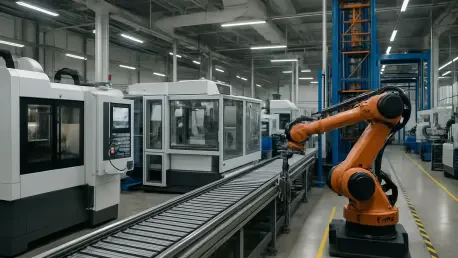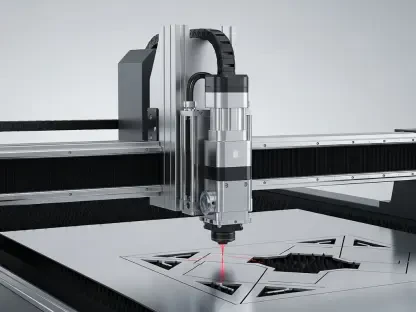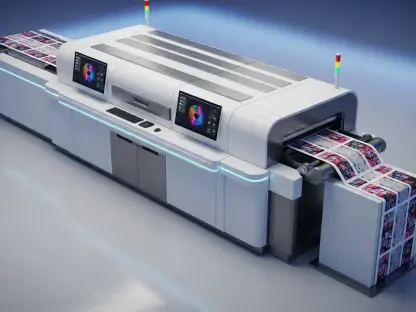Imagine a world where the surfboards slicing through ocean waves are not only custom-built for each rider but also crafted from the very plastic waste pulled from those same waters, transforming a vision into reality. This isn’t a distant dream but a tangible reality being shaped by additive manufacturing, more commonly known as 3D printing. This technology is redefining surfboard production, moving away from labor-intensive, wasteful methods to a precise, tech-driven approach. Companies like Wyve in France, alongside engineers from Université de Toulon, are at the forefront of this shift, creating boards that prioritize performance while addressing pressing environmental concerns. By replacing traditional foam cores with intricate lattice structures and exploring the use of recycled ocean plastics, 3D printing offers a dual promise: unparalleled customization for surfers and a significant step toward sustainability in an industry often criticized for its ecological footprint. This transformation signals a broader trend in manufacturing, where innovation and environmental responsibility are becoming inseparable.
Breaking Away from Traditional Craftsmanship
The art of crafting surfboards has long been rooted in manual labor, where artisans shape polyurethane or polystyrene foam blanks before sealing them with fiberglass and resin. This hands-on process, while steeped in tradition, often results in inconsistency, generates substantial waste, and exposes workers to harmful dust and chemicals. In stark contrast, 3D printing introduces a level of precision that traditional methods simply cannot match. Wyve’s approach involves creating skeletal lattice structures as the core of the board, eliminating the need for foam entirely. These structures provide enhanced rigidity and allow for designs that can be tailored to specific wave conditions or rider preferences. This shift isn’t merely about replacing one material with another; it’s about reimagining the entire production process to minimize environmental impact while maximizing structural integrity, setting a new benchmark for how sports equipment can be made in a modern, responsible way.
Beyond the environmental and structural benefits, the move to 3D printing also addresses the inherent variability of handmade boards. Traditional shaping relies heavily on the skill of individual craftsmen, often leading to subtle differences that affect performance. With additive manufacturing, digital models ensure consistency across every board produced, as each design is replicated with exacting detail. Wyve, in collaboration with academic partners, has harnessed this technology to create prototypes that withstand the rigors of surfing far better than many conventional models. The ability to control every aspect of the board’s internal framework means that issues like flex or weight distribution can be fine-tuned before production even begins. This precision not only improves the surfing experience but also reduces the trial-and-error waste associated with older methods, marking a significant departure from the empirical nature of past practices toward a data-driven future.
Innovations in Production Techniques
At the heart of this revolution lies the sophisticated use of large-format fused filament fabrication printers, which Wyve employs to construct full-scale surfboard skeletons. These printers create intricate honeycomb lattice designs that strike an ideal balance between lightweight construction and robust stiffness. Recent advancements, such as non-planar printing techniques where multiple axes move in sync, have drastically reduced production times. For instance, a board just under 6 feet can now be printed in a remarkable 19 hours, a fraction of the time older methods required. Post-printing, the skeleton undergoes lamination with fiberglass and bio-based epoxy resin through vacuum bagging, a process that ensures uniform coverage and minimizes excess material. The resulting boards boast exceptional durability, often lasting several times longer than traditional competition models, though they remain vulnerable to extreme forces like heavy impacts on flat water.
Further enhancing the production process is the focus on material efficiency and waste reduction. Unlike the foam-shaping method that generates significant offcuts and dust, 3D printing builds structures layer by layer, using only what is necessary for the design. This additive approach aligns with broader manufacturing trends that prioritize resource conservation. The vacuum bagging technique used in lamination also plays a critical role, as it prevents overuse of resin and ensures a smoother, more consistent finish compared to manual application. While the technology is not without limitations—such as the time-intensive nature of printing larger boards or the need for specialized equipment—it represents a substantial leap forward. The durability gains alone suggest a future where surfers replace their gear less frequently, indirectly cutting down on production demands and waste, a benefit that resonates deeply in an industry seeking greener solutions.
Personalization for Optimal Performance
One of the most exciting aspects of 3D-printed surfboards is the unprecedented level of customization they offer. The lattice structures at the core of these boards can be modified in specific zones—made lighter in low-stress areas like the nose to reduce weight, or reinforced in high-pressure spots where a surfer’s feet exert force. This adaptability ensures that each board can be precisely tuned to match a rider’s skill level, body type, or the unique demands of different wave conditions. Such personalization mirrors the bespoke equipment seen in other high-performance sports like skiing or cycling, where gear is often tailored to the athlete. For surfers, this means a board that feels like an extension of their own movements, enhancing control and responsiveness in ways that mass-produced or hand-shaped options rarely achieve, fundamentally changing the relationship between rider and equipment.
This customization extends beyond mere aesthetics or comfort; it directly impacts performance outcomes. Traditional surfboard manufacturing struggles to scale personalized designs due to the labor and cost involved in manual shaping. With 3D printing, digital design files can be adjusted with ease, allowing for rapid iterations based on feedback or testing data. Wyve’s approach exemplifies this, as their technology enables quick modifications to internal structures without overhauling the entire production process. The result is a board that can adapt to a beginner needing stability or a professional seeking agility on aggressive waves. This level of detail not only elevates the sport but also democratizes access to high-quality, custom gear, as the technology has the potential to lower costs over time through streamlined production, making tailored equipment more accessible to a wider range of enthusiasts.
Rigorous Testing for Real-World Results
Ensuring that 3D-printed surfboards perform as promised requires a meticulous blend of simulation and practical evaluation. Wyve collaborates with research facilities like the Mapiem Laboratory to conduct extensive testing, combining digital twins created through 3D scanning with real-time data from sensor-equipped boards. These sensors capture critical metrics like flex patterns and applied forces during surfing sessions, while artificial wave facilities provide controlled environments to replicate consistent conditions—a stark contrast to the unpredictable nature of the ocean. This methodical approach allows engineers to correlate board behavior with surfer muscle activity, refining designs to achieve the perfect balance for any rider-wave combination. Such precision in testing ensures that theoretical models translate effectively into tangible performance gains out on the water.
The challenges of testing in natural settings are significant, as variables like wave height and wind can skew results. By leveraging controlled wave pools, researchers can isolate specific factors and repeat experiments under identical conditions, yielding reliable data that would be nearly impossible to gather in the open sea. This data-driven process also involves material analysis, particularly of biopolymers used in printing, to assess their mechanical properties and degradation in marine environments. The insights gained from these experiments are invaluable, guiding adjustments to lattice density or resin composition to enhance durability and responsiveness. While this rigorous testing adds time to the development cycle, it underscores a commitment to quality, ensuring that when these boards reach surfers, they deliver on the promise of innovation, bridging the gap between cutting-edge tech and the raw, dynamic experience of riding a wave.
Driving Sustainability Through Innovation
Sustainability lies at the core of this technological shift, with Wyve pioneering efforts to transform ocean plastic waste into functional surfboard components. Their process involves collecting discarded bottles from beaches and converting them into filament for 3D printing, with each bottle producing roughly 10 meters of usable material. Initial tests of this recycled polymer have revealed impressive stiffness, sometimes exceeding expectations by a wide margin. However, scaling this initiative to mass production remains a hurdle due to inconsistencies in processing the reclaimed plastic. Despite these challenges, the endeavor reflects a growing imperative in engineering to merge high performance with ecological responsibility. Turning marine debris into sports equipment not only tackles pollution but also raises awareness of the urgent need to address waste in coastal ecosystems, positioning this project as a beacon for sustainable manufacturing.
The broader implications of using recycled materials in surfboard production are profound, as they align with global efforts to combat plastic pollution. While the current limitations in processing consistency mean that fully recycled boards are not yet widely available, the potential is undeniable. Every successful prototype brings the industry closer to a circular economy model, where waste is repurposed rather than discarded. This initiative also highlights the intersection of technology and environmental stewardship, demonstrating that innovation can serve a dual purpose—enhancing product quality while reducing ecological harm. As research progresses, solutions to these processing challenges are likely to emerge, paving the way for a future where the majority of surfboards could be made from materials once destined for landfills or oceans, fundamentally altering the environmental narrative of the sport.
Shaping a Greener Horizon for Surfing
Reflecting on the strides made through 3D printing, it’s evident that Wyve and their academic collaborators have carved a path that others in the industry could follow. Their efforts over recent years have demonstrated how additive manufacturing tackles longstanding issues of waste and inconsistency in surfboard production, delivering boards that are not only more durable but also highly customizable. The integration of recycled ocean plastics, though still in early stages, showcases a viable route to reducing the sport’s environmental toll. Each board printed and tested moves the needle toward a more sustainable standard, proving that technology can harmonize with nature rather than exploit it.
Looking ahead, the next steps involve overcoming the remaining barriers, such as refining the processing of recycled materials for consistent quality at scale. Investment in faster printing technologies could further slash production times, making these boards more accessible. Additionally, expanding testing protocols to include a wider range of surfing conditions will ensure broader applicability. Partnerships between industry innovators and environmental organizations might accelerate the adoption of these practices, setting a precedent for other sports to integrate sustainability into their core designs. The groundwork laid thus far offers a blueprint for balancing performance with planetary care, urging stakeholders to build on this momentum for a future where every wave ridden contributes to a cleaner ocean.









